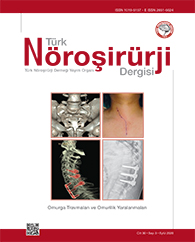Türk Nöroşirürji Dergisi
2020 , Vol 30 , Num 3
Approaches to Thoracolumbar Junction Fractures
1İnönü Üniversitesi, Beyin ve Sinir Cerrahisi Anabilim Dalı, Malatya, Türkiye2Uludağ Üniversitesi, Beyin ve Sinir Cerrahisi Anabilim Dalı, Bursa, Türkiye Thoracolumbar junction fractures are fractures including the T10-L2 vertebrae. The evaluation of the stability/instability of a thoracolumbar junction fracture is important in forming the treatment algorithm. According to Denis" three-column theory in thoracolumbar junction fractures, a fracture only in the anterior and posterior columns is considered stable, but it is considered unstable if there is also a fracture in the middle column in addition to these stable fractures. The presence of posterior ligament damage in magnetic resonance imaging is regarded as an important indicator of instability. The general opinion is to use conservative treatment for stable thoracolumbar junction fractures, and surgical treatment for unstable vertebra fractures. The posterior approach is preferred among the surgical treatment options due to the development of instrumentation systems and as it allows 360-degree decompression. However, anterior and anterior-posterior approaches are used in suitable patients. The conservative treatment option is left out taking into account the inadequate pain management, prolonged duration of rest before returning to work, development of instrumentation systems, orthosis compliance, complications, and the surgeon"s experience. The gold standard treatment approach has not been standardized yet. Anahtar Kelimeler : Thoracolumbar junction, Fracture, Instability, Conservative treatment, Surgical therapy, Patient selection

